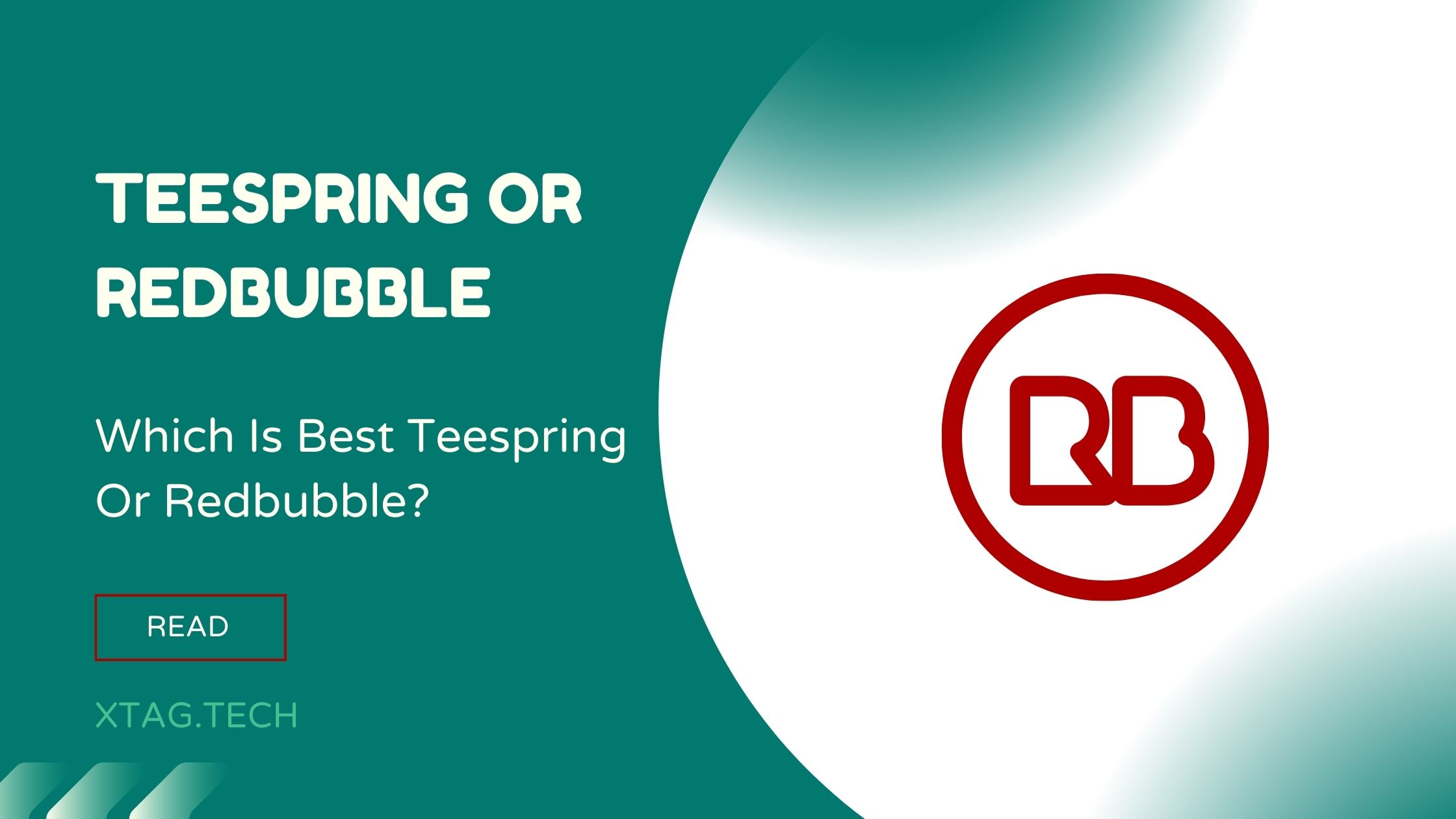In the ever-evolving world of print-on-demand, two giants stand out: Teespring and Redbubble. These platforms have revolutionized the way artists, designers, and entrepreneurs bring their creations to life on various products. As the demand for personalized merchandise continues to surge, choosing the right platform becomes crucial for success.
Both Teespring and Redbubble offer a myriad of opportunities for individuals to turn their creative endeavors into tangible products. Whether you’re an artist looking to showcase your designs on T-shirts, mugs, or phone cases, or an entrepreneur seeking to start your own clothing line, the decision between Teespring and Redbubble can significantly impact your venture’s trajectory.
In this article, we’ll embark on a comprehensive exploration of these two platforms, examining aspects like ease of use, product range, quality, pricing structures, profit margins, marketing tools, visibility, community support, copyright considerations, and success stories. By the end, you’ll be equipped with the insights needed to make an informed decision about which platform aligns best with your goals and aspirations. Let’s dive in!
Overview of Teespring

Teespring is an innovative online platform that empowers individuals to create and sell customized merchandise with ease. Established in 2011, Teespring allows users to design and sell a wide range of products, including apparel, accessories, home decor, and more. With a user-friendly interface and robust features, Teespring simplifies the entire process of creating and marketing custom products.
Teespring offers a plethora of features designed to enhance user experience and maximize profit margins. From a variety of design options to integration with popular e-commerce platforms, Teespring provides a comprehensive toolkit for individuals and businesses looking to monetize their creative endeavors.
Overview of Redbubble

On the other hand, Redbubble is another leading online marketplace that enables artists and designers to showcase their creativity by selling unique, personalized designs on various products. Established in 2006, Redbubble has evolved into a global platform that hosts a diverse community of artists and art enthusiasts.
Redbubble’s appeal lies in its extensive range of products, allowing artists to showcase their designs on everything from clothing and accessories to stationery and home decor. The platform offers a user-friendly interface, enabling artists to easily upload their designs, set their prices, and reach a broad audience.
Comparison of Teespring and Redbubble.
When venturing into the world of print-on-demand, one of the initial considerations is the ease of use of the chosen platform. Both Teespring and Redbubble aim to provide user-friendly interfaces, but let’s break down their respective strengths.
Pricing and Profit Margins
When it comes to pricing and profit margins, both Teespring and Redbubble offer different approaches. Teespring follows a base cost pricing model where you set your selling price on top of the base cost, determining your profit. Redbubble, on the other hand, suggests a base price, and you can set your markup to determine your earnings.
In terms of profit margins, Teespring may offer slightly higher profit potential due to its base cost model. However, Redbubble provides a balance by allowing you to set competitive prices to attract a wider customer base.
Design Options and Customization

Both platforms provide ample design options and customization features. Teespring offers an intuitive design tool, making it easy to create and customize designs for your products. Additionally, Teespring allows for the creation of campaigns and product launches, enhancing marketing efforts.
Redbubble, on the other hand, boasts a vast array of products and allows artists to showcase their designs on a diverse range of items. The platform provides easy-to-use design tools and encourages artistic freedom, enabling designers to create unique and captivating designs.
Quality and Customer Service
Quality is a paramount consideration for both platforms. Teespring maintains a reputation for high-quality printing and durable products. They have invested in quality control to ensure customer satisfaction, which is critical for any business.
Redbubble also emphasizes quality, offering high-grade printing and quality materials for their products. Both platforms have customer support, but Teespring is particularly known for its responsive and helpful customer service.
Market Reach and Audience

In terms of market reach, Redbubble has a broader international presence and a larger customer base, given its longer tenure in the market. It attracts a diverse audience and has a strong foothold in the art and design community. Teespring, while widely recognized, may have a slightly narrower reach.
Integration and Ease of Use
Teespring provides seamless integration with e-commerce platforms like Shopify and WooCommerce, simplifying the process of setting up an online store. The platform offers easy-to-navigate dashboards and a straightforward campaign creation process.

Redbubble is equally user-friendly, with a simple interface for uploading designs and managing your store. It also allows integration with various social media platforms, enabling artists to promote their work effectively.
Pros and Cons of Each Platform
| Teespring Pros | Teespring Cons |
|---|---|
| Base cost pricing model | Slightly limited product range |
| High profit potential | Limited design freedom |
| Integrated e-commerce integration | Restricted international reach |
| Redbubble Pros | Redbubble Cons |
|---|---|
| Diverse product range | Pricing structure may limit profits |
| Larger international customer base | High competition among designers |
| Extensive design customization options | Lower profit margins compared to some |
Real-life User Experiences
Teespring User Experiences
1. Sarah’s Success Story:
Sarah, a budding graphic designer, opted for Teespring to kickstart her merchandise line. She appreciated Teespring’s straightforward design tools and the ability to easily set her profit margins. Sarah found Teespring’s customer service prompt and helpful when she encountered an issue with one of her campaigns.
2. Mark’s Feedback:
Mark, an e-commerce entrepreneur, lauded Teespring’s integration capabilities. The smooth integration with his existing online store streamlined his business operations. He also appreciated the competitive profit margins offered by Teespring.
Redbubble User Experiences
1. Emma’s Perspective:
Emma, an artist with a penchant for abstract designs, found Redbubble to be an ideal platform to showcase her artwork. She loved the vast array of products she could feature her designs on and was thrilled by the international exposure her creations received through Redbubble.
2. James’ Journey:
James, a seasoned artist, noted the ease of use and wide reach of Redbubble. He mentioned how hassle-free it was to upload his designs and set prices. The fact that Redbubble handles printing, shipping, and customer service was a significant time saver for him.
Success Stories
For aspiring creators and entrepreneurs, success stories can serve as a source of inspiration and guidance. Let’s explore some noteworthy success stories from both Teespring and Redbubble, shedding light on how these platforms have empowered individuals to turn their passion into profit.
Teespring Success Stories
Case Study 1: The Niche Master
Meet Sarah, a graphic designer who found her niche on Teespring. By creating quirky and niche-specific designs, she tapped into markets that were underserved. Through strategic marketing on social media platforms, Sarah’s designs gained traction, leading to a surge in sales. Teespring’s analytics tools played a pivotal role in helping her identify the most lucrative niches and tailor her designs accordingly.
Case Study 2: The Social Media Maven
John, an aspiring influencer, leveraged Teespring’s integration with social media platforms to boost his brand. By creating merchandise featuring his catchphrases and iconic symbols, John engaged his followers and turned them into loyal customers. Teespring’s seamless integration with Facebook and Instagram allowed him to reach a broader audience and drive sales.
Redbubble Success Stories
Case Study 1: The Global Artist
Emily, an artist with a passion for global cultures, found her canvas on Redbubble. By creating designs inspired by diverse traditions and ethnicities, Emily’s artwork resonated with a global audience. Redbubble’s international shipping capabilities played a crucial role in her success, allowing her to reach customers worldwide. The platform’s emphasis on artistic expression aligned perfectly with Emily’s vision.
Case Study 2: The Trend Tracker
Michael, a keen observer of trends, used Redbubble to capitalize on the latest crazes. Whether it was memes, pop culture references, or current events, Michael transformed timely ideas into captivating designs. Redbubble’s quick turnaround time and ability to swiftly incorporate new products allowed him to stay ahead of the curve and cater to the ever-changing tastes of his audience.
Learning from Successful Creators
Both Teespring and Redbubble have proven to be launchpads for success stories across various niches. What these success stories highlight is the importance of understanding your audience, identifying unique selling points, and leveraging the platform’s features to your advantage.
As you embark on your journey, consider these success stories not as mere anecdotes but as valuable lessons. What worked for Sarah, John, Emily, and Michael may provide insights into strategies that align with your own goals and creative vision.
In the upcoming sections, we’ll delve deeper into crucial aspects such as pricing structures, profit margins, marketing tools, and community support, offering a comprehensive guide to help you navigate the decision between Teespring and Redbubble effectively. Stay tuned for insights that will empower you on your print-on-demand journey!
Conclusion
In the ongoing debate of Teespring vs. Redbubble, the decision ultimately rests on your specific needs and priorities. Both platforms offer unique advantages and cater to different types of users.
If you prioritize profit margins and seamless e-commerce integration, Teespring might be the better fit for you. The base cost pricing model and integration capabilities make it attractive for entrepreneurs looking to maximize profits and streamline their business operations.
On the other hand, if you are an artist seeking a broader audience and a diverse range of products to feature your designs, Redbubble is an excellent choice. Its extensive product range and international customer base provide a platform to showcase and sell your artwork globally.
Consider your design style, target audience, desired profit margins, and preferred level of customization when making your decision.
Remember, success on these platforms often lies in your creativity, marketing strategies, and understanding of your target audience.
FAQs
1. Can I use both Teespring and Redbubble simultaneously?
Yes, you can use both platforms simultaneously to maximize your reach and potential sales. Many creators opt to use multiple platforms to diversify their income streams.
2. Are there any listing fees on Teespring or Redbubble?
No, both Teespring and Redbubble do not charge any listing fees. You can upload as many designs as you want without incurring any upfront costs.
3. Which platform offers better printing quality?
Both platforms are known for their quality printing. Teespring and Redbubble utilize state-of-the-art printing technologies to ensure the designs on their products are vibrant and durable.
4. How long does it take to receive payments from Teespring and Redbubble?
Teespring typically pays creators within 24-48 hours after a sale is made. Redbubble pays creators their earnings once a month, usually during the first week of the month.
5. Can I edit my designs after uploading them to Teespring and Redbubble?
Yes, both platforms allow you to edit your designs even after uploading them. You can make changes to your designs, adjust prices, and update product details as needed.
